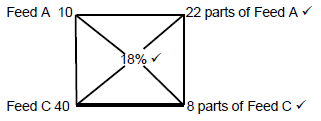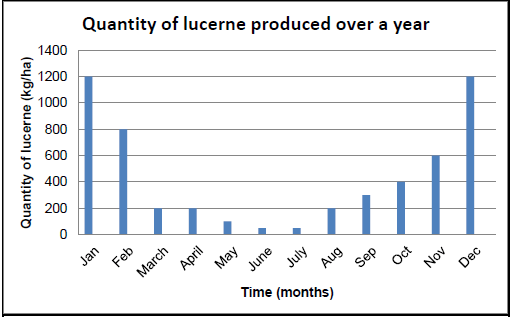Agricultural Sciences Paper 1 Memorandum - Grade 12 September 2021 Preparatory Exams
Share via Whatsapp Join our WhatsApp Group Join our Telegram GroupMEMORANDUM
SECTION A
QUESTION 1
1.1
1.1.1 C
1.1.2 B
1.1.3 C
1.1.4 D
1.1.5 A
1.1.6 D
1.1.7 B
1.1.8 C
1.1.9 D
1.1.10 C (10 x 2) (20)
1.2
1.2.1 B only
1.2.2 A only
1.2.3 None
1.2.4 B only
1.2.5 Both A and B (5 x 2) (10)
1.3
1.3.1 Biological value/BV
1.3.2 Quarantine
1.3.3 Cryptorchidism
1.3.4 Impotence
1.3.5 Freemartin (5 x 2) (10)
1.4
1.4.1 Lipase
1.4.2 Weaning
1.4.3 Colostrum/beestings
1.4.4 Ovum/egg cell
1.4.5 Repeat breeder (5 x 1) (5)
TOTAL SECTION A: 45
SECTION B
QUESTION 2: ANIMAL NUTRITION
2.1 Digestion in farm animals
2.1.1 Indication whether the teeth represent the lower or upper jaws
- Lower jaw (1)
2.1.2 Naming the type of digestion done by the teeth
- Physical (1)
2.1.3 Explaining the importance of teeth together with saliva in FARM ANIMAL 1
- Teeth break down large food particles into smaller particles Saliva moistens, softens and bind the particles together to form a bolus (2)
2.1.4 Part of a fowl that performs the same function done by teeth
- Ventriculus/gizzard (1)
2.1.5 Explanation of the path of milk in FARM ANIMAL 2
- Milk flows from the mouth to the oesophogal groove and land directly into the abomasum (2)
2.2 Villi
2.2.1 Part in the alimentary canal where villi is found
- Small intestines (1)
2.2.2 Indication of the nutrient absorbed in part A and B Part A – Digested protein and carbohydrates
- Part B – Digested fats (2)
2.2.3 Process that follows after the absorption of nutrients
- Assimilation (1)
2.2.4 ONE adaptation feature of the villi
- Presence of blood and lymph capillaries
- Microvilli to increase the surface area for absorption
- Thin layer of epithelial cells with carrier molecules (Any 1 x 1) (1)
2.3 Feed components
2.3.1 Identification of the feed suitable for:
- Young growing animals – Feed C
- Fattening old ewes – Feed A
- Insulation against temperature changes – Feed B (3)
2.3.2 Calculation of the nutritive ratio of feed B
- NR = 1 : %TDN -– % DP
% DP
1 : 85% – 20%
20%
1 : 3,25
OR
NR = 1 : % digestible non-nitrogen substances
% digestible protein
1 : 65
20
1 : 3,25 (3)
2.3.3 Determining the ratio of feed A and feed C to be mixed to get a feed with 18% DP
Ratio of feed A : Feed C is 22 : 8 (4)
2.4 Growth stimulants
Naming the most applicable substance:
- Tranquilisers
- Thyroid regulator (2)
2.5Fodder flow
2.5.1 Bar graph
Criteria/rubric/marking guideline
- Correct heading
- x-axis: Correctly calibrated and labelled (Time)
- y-axis: Correctly calibrated and labelled (Quantity of lucerne)
- Correct units (kg/ha and months)
- Bar graph
- Accuracy (6)
2.5.2 Calculation of the total amount of lucerne the cows will need in June
- Number of animal x requirement/kg/day x 30
= 35 x 5 kg x 30
= 5 250 kg (2)
2.5.3 Determination of whether there will be enough lucerne for these lactating cows in June
- Supply in June = 50 kg/Ha x 42 hectares
= 2 100 kg
2 100kg – 5 250 kg – 3 150 kg
There will be a shortage of 3 150 kg. (3)
[35]
QUESTION 3: ANIMAL PRODUCTION, PROTECTION AND CONTROL
3.1 Production system
3.1.1 Identification of the animal production system
- Extensive production system (1)
3.1.2 TWO reasons
- Lot of space and few animals/low-density
- Animal production adapted to existing environment/environment not modified
- Low input costs
- Use of thorny shrubs as fencing (Any 2 x 1) (2)
3.1.3 Linking the production system with a relevant farming system
- Subsistence (1)
3.1.4 Identification of the measures to increase animal production under the following:
- Nutrition – Planting of the kikuyu
- Reproduction – Breeding animals adapted to the environment
- General enterprise management – Dividing grazing area into camps/practising rotational grazing (3)
3.2 Facilities/equipment
3.2.1 Identification of the facilities/equipment
- PICTURE B – Furrowing crate
- PICTURE D – Drinker (2)
3.2.2 Purpose of using the facility
- Labelled A in PICTURE C – to restrain an animal (1)
3.2.3 TWO design features of the facility labelled B in PICTURE C
- Should have high solid sides to prevent animals from seeing out
- Narrow curved/not curved too sharply (2)
3.2.4 Indication of the information to be included in the permit
- Details of the owner
- Number of animals
- Type of animals
- Description of animals
- Registration number of the vehicle
- Destination to which animals are being taken
- Name and ID number of the driver (Any 2 x 1) (2)
3.3 Animal handling and behaviour
3.3.1 TWO signs of pigs in distress
- Tail biting
- Ear biting
- Cannibalism
- Belly nibbling
- Snout rubbing (Any 2 x 1) (2)
3.3.2 TWO effects of incorrect handling of animals during transportation
- Animals will be injured
- Delayed rigor mortis
- Poor quality of meat (Any 2 x 1) (2)
3.4 Diseases
3.4.1 TWO signs showing that the animal is sick
- Dull glossy eyes
- pink membrane around the eyes
- Rapid pulse rate
- Laboured breathing
- Animal walks slowly or limps when forced to walk
- Discoloured urine and faeces may be too hard or too soft
- Dull rough coat (Any 2 x 1) (2)
3.4.2 TWO methods a farmer can use to test animal health
- Taking an animal’s temperature
- Determining pulse rate
- Determining respiratory rate (Any 2 x 1) (2)
3.5 Life cycle of an anthrax
3.5.1 Indication of the pathogen
- Bacteria (1)
3.5.2 TWO ways in which the disease can be transmitted
- Ingestion of the animal product
- Inhalation
- Cutaneous/through the skin (Any 2 x 1) (2)
3.5.3 Justification that the disease is zoonotic
- It is transferred from the animals to human beings (2)
3.5.4 TWO steps the farmer can take to prevent further spread of the disease
- Burn or bury the carcasses of infected animals
- Dispose all manure, bedding and other contaminated materials
- Clean and disinfect stables, pens, milking parlours and all equipment (Any 2 x 1) (2)
3.6Ticks
3.6.1 Classification of the parasite
- External parasite (1)
3.6.2 Reason
- They create an opening on the skin of an animal (1)
3.6.3 Name of the tick belonging to the following class:
- Three-host tick – Bont tick
- One-host tick – Blue tick (2)
3.6.4 TWO economic impacts of ticks for the farmer
- Decreased production
- Decreased income/profit
- High cost of treatment (Any 2 x 1) (2)
[35]
QUESTION 4: ANIMAL REPRODUCTION
4.1 Reproductive systems
4.1.1 Identify the letter
- B (1)
- I (1)
- G (1)
- Diagram A – C
Diagram B – J (2)
4.1.2 Naming the inner and the middle membranes surrounding the foetus
- Inner membrane – Amnion
- Middle membrane – Allantois (2)
4.1.3 Explanation of the role of the parts
- Part A – Regulates the temperature of the testis for optimum sperm production
- Part F – Collects the ovum released during ovulation (2)
4.2 Reproductive processes
4.2.1 Identification of the processes
- B – Fertilisation
- C – Pregnancy/gestation (2)
4.2.2 Indication of the first and the last stage of pregnancy
- First stage– Ovum phase
- Last stage- Foetal stage (2)
4.2.3 Name of the process labelled A
- Artificial Insemination/AI (1)
4.2.4 TWO economic benefits of artificial insemination for the farmer
- Less expensive because there is no need to buy a bull
- Large number of offspring can be produced from the superior bulls
- Semen of superior bulls can be used even after death
- Semen of multiple sires can be used without maintaining many expensive bulls
- Higher conception rate is achieved (Any 2 x 1) (2)
4.2.5 TWO factors causing retention of placenta
- Deficiency of vitamin A
- Sexually transmitted diseases
- Infections/abortion
- Exhaustion following difficult calving
- Mineral deficiency
- Hereditary defects
- Over-conditioning of dry cows (Any 2 x 1) (2)
4.3 Cloning
4.3.1 Identification of the reproductive process
- Cloning/nuclear transfer (1)
4.3.2 Explanation of a reason
- Somatic cell from the donor is fused with a nucleated egg cell giving rise to an offspring that is genetically identical to the donor sheep (2)
4.3.3 Naming of the process
- Enucleation (1)
4.3.4 Indication of the letter of the sheep
- D
- A
- B (3)
4.3.5 TWO aims of the cloning
- Produce large number of genetically identical animals
- Produce offspring from high quality animals
- Preserve and extend proven superior genetics
- Achieve high quality meat and dairy products
- Increase number of endangered species (Any 2 x 1) (2)
4.4 Udder and lactation
4.4.1 Identification of parts
- A – Alveoli
- B – Lobe
- C – Teat (3)
4.4.2 Indication of the role of alveoli
- It is where milk is formed (1)
4.4.3 Naming the stage in the lactation cycle between month 10 and the next calving period
- Dry/rest period (1)
4.4.4 Importance of dry period for lactating cow
- To give time for glandular tissue of the udder to recover and prepare for optimum milk production in the next lactation cycle (2)
4.4.5 Identification of the number of months’ lactation period last
- 10 months (1)
[35]
TOTAL SECTION B: 105
GRAND TOTAL: 150